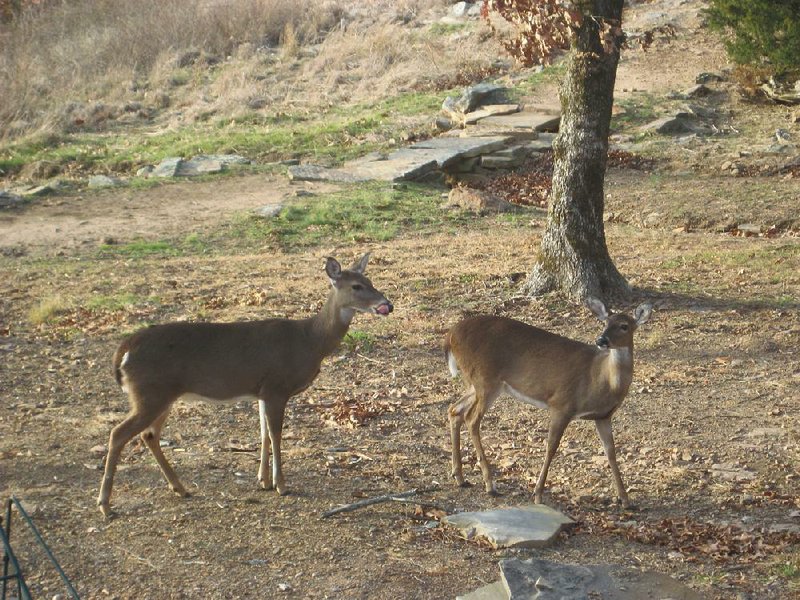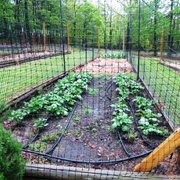Who didn’t get misty-eyed when Bambi lost his mother in the Walt Disney classic? But when Mother or Bambi starts munching on the prized roses, azaleas or vegetables, the well of sympathy runs dry. Many a docile gardener becomes a hunter.
Deer are no longer just a problem for folks who live in the country. Each year, ruminant-ravaged vegetable plots and decorative borders become more widespread as the urban and rural areas entwine. What is a gardener to do?
For animal problems of any kind, there is no hard and fast answer that will work in every situation. While some may say a good shotgun is the answer, try telling that that to a city dweller or to your local game ranger if it isn’t deer season.
But there are options. First and foremost, consider planting deer-resistant plants - those not as palatable to the deer.
Deer prefer a bland diet. Unless they are starving, they will pass by most aromatic or poisonous plants, as well as those with irritating saps.
NOT PICKY EATERS
White tailed deer are herbivores, and they eat a wide array of plant materials. Their diet changes depending on the season and what they find available.
Typically, a deer eats green plants in the spring and summer,and corn, acorns and other nuts in the fall. In the winter, it eats the buds and twigs of woody plants - sometimes it eats the plant all the way to the ground.
Their stomachs can digest twigs along with leaves, fruits, nuts, grass, corn and even lichens.
They are mainly nocturnal, so you usually find them browsing mainly at dawn and dusk. But if populations grow large enough, they will wander out during the day.
COMEBACK KIDS
Deer were a mainstay of the Arkansas diet during settlement days. By the early 1900s, deer numbers had drastically declined. A legislative act in 1916 established a hunting season for deer, turkey and bear to help manage the wildlife population. The newly established deer season allowed a bag limit of two bucks.
At that time the statewide deer population was about 2,000. By the 1920s deer had been eliminated from many counties, leaving an estimated 500 deer statewide. Today’s herd is estimated to be nearly 1 million animals and growing.
While the comeback of the white tailed deer is considered by some to be the most successful conservation initiative in history, some gardeners would disagree.
If you live in an area with heavy deer populations, there are a few options. You can use deer fencing, electric fences or chemical repellents; but a simpler and less expensive and less is to plant things deer don’t like to eat.
If you are a fruit or vegetable grower, deer like most of those plants as much as you do - with the exception of cucumbers, some years, and potatoes and tomatoes. For most vegetable gardens, deer fencing or electric fences to deter deer will be needed.
In the ornamental arena, you have more options. Deer love hosta - which we often call “the deer salad bar.” They also seem to enjoy roses, azaleas, lilies and tulips. If you must grow those, you’ll want to invest in fencing.
But if you are willing to confine your planting to items that are considered “deer-resistant,” here are some choices.
HERBS
You can try almost all of herbs. Deer are not fans of their aromatic foliage.
So there are a diverse mix of plants that are not as appetizing to deer as others. A deer-resistant garden can be a vivid, beautiful and satisfying place.
ON THE OTHER HAND ...
It’s not hard to make lists of deer-resistant plants based on taste and digestibility, but keep in mind that the deer haven’t read the list. If they are hungry enough, they will eat them.
If you already have established your landscape using non-deerproof plants, or you love azaleas and hostas and don’t want to do without them, then consider scare tactics, fencing or sprays.
There are a variety of commercial sprays on the market, but many home gardeners also have luck spraying a diluted milk or raw egg spray. The problem with sprays is you have to reapply in rainy weather, or when you irrigate a lot.
The key to solving any pest problem is to monitor your garden and try to respond quickly when problems hit. If you do lose a plant or two to deer, replace those delicious temptations with something deer won’t crave.
A combination approach - sensible deer-resistant plants along with a little fencing repellents, or both in extreme areas - could be required.
Perennials
Perennials that are more immune are Agastache, Ajuga, Asarum, ginger, astilbe, baptisia, bleeding heart, Brugmansia and Datura, butterfly weed, catmint (Nepeta), coreopsis, Euphorbia, ferns, forget-me-nots, four o’clocks, foxglove, hellebores, lamb’s ear, lamium, lavender, may apples, monkshood, peonies, periwinkle, ornamental grasses, rose campion, salvia and sweet woodruff.
Bulbs
For bulb plants, try alliums, crocus, daffodils, irises, lily of the valley, scilla and snowdrops.
Annuals
Some annuals to try are ageratum, bachelor’s buttons, calendula, cleome, cosmos, dusty miller, heliotrope, lantana, larkspur, marigold, nicotiana (flowering tobacco), annual poppies, salvia, snapdragon, strawflowers, sunflowers, sweet alyssum and zinnias.Shrubs
For shrubs, consider barberry, boxwood, buckeye, buddleia (butterfly bush), camellias, caryopteris (blue mist shrub), crape myrtles, daphne, elderberry, eleagnus, some hollies , gardenia, junipers, kerria, leucothoe, oleander, santolina, Southern magnolias, mahonia, nandina, palms, pieris, plum yew (Cephalotaxus), spirea, sweet box (sarcoccoca), some viburnums, wax myrtle and yucca.
HomeStyle, Pages 37 on 09/21/2013


